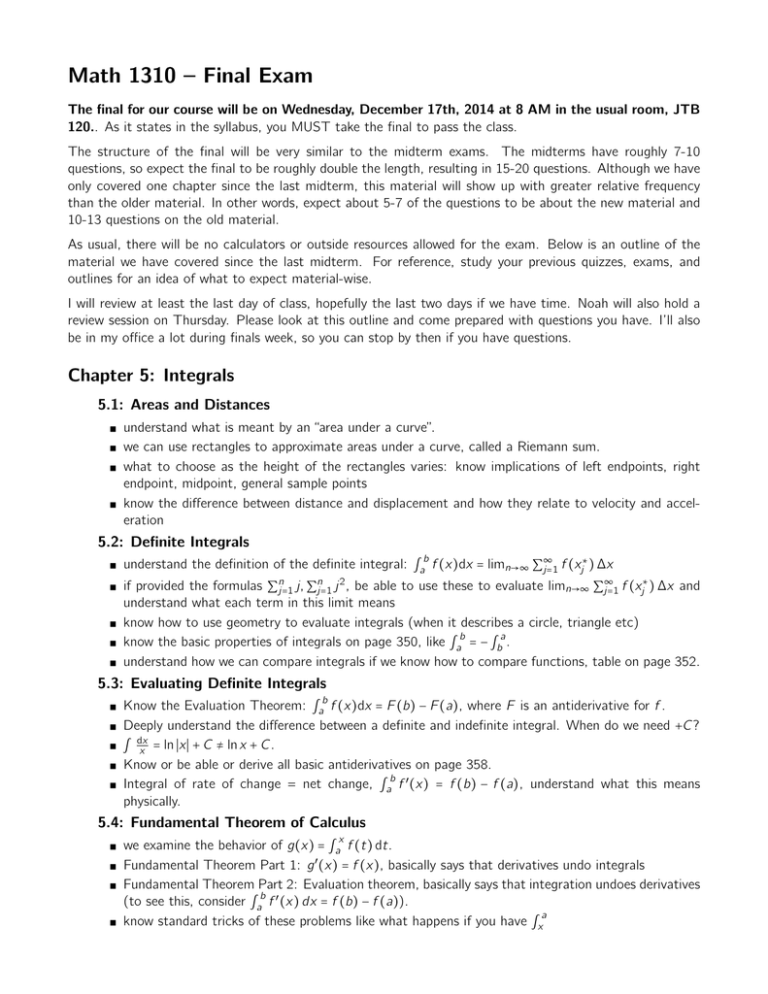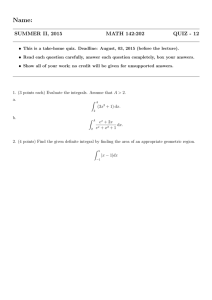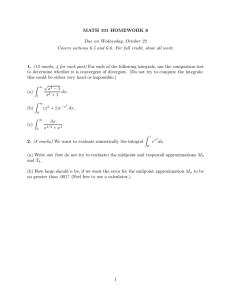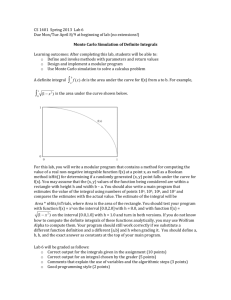Math 1310 – Final Exam
advertisement

Math 1310 – Final Exam The final for our course will be on Wednesday, December 17th, 2014 at 8 AM in the usual room, JTB 120.. As it states in the syllabus, you MUST take the final to pass the class. The structure of the final will be very similar to the midterm exams. The midterms have roughly 7-10 questions, so expect the final to be roughly double the length, resulting in 15-20 questions. Although we have only covered one chapter since the last midterm, this material will show up with greater relative frequency than the older material. In other words, expect about 5-7 of the questions to be about the new material and 10-13 questions on the old material. As usual, there will be no calculators or outside resources allowed for the exam. Below is an outline of the material we have covered since the last midterm. For reference, study your previous quizzes, exams, and outlines for an idea of what to expect material-wise. I will review at least the last day of class, hopefully the last two days if we have time. Noah will also hold a review session on Thursday. Please look at this outline and come prepared with questions you have. I’ll also be in my office a lot during finals week, so you can stop by then if you have questions. Chapter 5: Integrals 5.1: Areas and Distances ∎ ∎ ∎ ∎ understand what is meant by an “area under a curve”. we can use rectangles to approximate areas under a curve, called a Riemann sum. what to choose as the height of the rectangles varies: know implications of left endpoints, right endpoint, midpoint, general sample points know the difference between distance and displacement and how they relate to velocity and acceleration 5.2: Definite Integrals ∎ ∎ ∎ ∎ ∎ ∗ understand the definition of the definite integral: ∫a f (x)dx = limn→∞ ∑∞ j=1 f (xj ) ∆x ∗ if provided the formulas ∑nj=1 j, ∑nj=1 j 2 , be able to use these to evaluate limn→∞ ∑∞ j=1 f (xj ) ∆x and understand what each term in this limit means know how to use geometry to evaluate integrals (when it describes a circle, triangle etc) b a know the basic properties of integrals on page 350, like ∫a = − ∫b . understand how we can compare integrals if we know how to compare functions, table on page 352. b 5.3: Evaluating Definite Integrals ∎ ∎ ∎ ∎ ∎ b Know the Evaluation Theorem: ∫a f (x)dx = F (b) − F (a), where F is an antiderivative for f . Deeply understand the difference between a definite and indefinite integral. When do we need +C? dx ∫ x = ln ∣x∣ + C ≠ ln x + C. Know or be able or derive all basic antiderivatives on page 358. b Integral of rate of change = net change, ∫a f ′ (x) = f (b) − f (a), understand what this means physically. 5.4: Fundamental Theorem of Calculus ∎ ∎ ∎ ∎ x we examine the behavior of g(x) = ∫a f (t) dt. Fundamental Theorem Part 1: g ′ (x) = f (x), basically says that derivatives undo integrals Fundamental Theorem Part 2: Evaluation theorem, basically says that integration undoes derivatives b (to see this, consider ∫a f ′ (x) dx = f (b) − f (a)). a know standard tricks of these problems like what happens if you have ∫x ∎ x2 know how to use the chain rule with FTC, like if we had ∫a cos rule with g(u). √ tdt. Here, let u = x 2 and chain 5.5: u-substitution ∎ ∎ ∎ ∎ ∎ ∎ whole idea: exploit chain rule to evaluate hard integrals that look like: (something) ⋅ (derivative of same thing) actual statement: ∫ f (g(x)) g ′ (x) dx = ∫ f (u) du where u = g(x). practical idea: choose u = g(x) and then du = g ′ (x) dx. When you substitute these in, hopefully all x’s eliminate. Otherwise, you picked wrong u and start over No clear cut way of choosing u, trial and error and practice. when you have definite integrals, you have to make the change of bounds, for instance if you have 1 2 ∫0 f (x) dx and u = x + 1, our new bounds become u = 1, 2, so ∫1 f (u)du a know what the behavior of ∫−a f (x) dx is for even and odd f 5.6: Integration by Parts ∎ ∎ ∎ ∎ ∎ ∎ ∎ Whole idea stems from the product rule, can think of it as the product rule for integration Shorthand: ∫ udv = uv − ∫ v du √ How to choose u? LIATE: Logarithms, Inverse Trig, Algebraic expressions ( x, x 2 ), Trig Functions, Exponentials. Start with L and go down the list. That is, logs are best choice for u. Once you choose u, the rest of the integral must then be dv know how to do IBP when you have a definite integral (just evaluate v u) be familiar with IBP that cycles like ∫ e x sin x dx sometimes you have to do IBP more than once 5.7: Other integration techniques ∎ ∎ ∎ ∎ ∎ ∎ ∎ ∎ Odd trig function powers: ∫ cos3 x dx: use a trig identity like sin2 x + cos2 x = 1. even trig powers: use a double angle formula like: sin2 x = 21 (1 − cos 2x). √ √ √ Trig substitutions: when you have a2 − x 2 , a2 + x 2 , x 2 − a2 . Be able to do these if I give you the substitution Partial fractions: when you can split up the denominator into several factors Very general and useful technique: know all the cases! Particularly, know how to solve for unknown coefficients A, B, C etc. Two ways: either matching powers of x or just plugging in x values. Know what to do when you have a double root, triple root, unfactorable roots, unfactorable double roots etc. We did all of these in class. = 1a tan−1 (x/a) + C. Helpful: ∫ x 2dx +a2 5.10: Indefinite Integrals ∎ ∎ ∎ ∎ ∎ ∎ ∎ ∞ Type 1: taking bounds of integral to go to ∞, like ∫1 dx/x 2 . understand what it means to be convergent or divergent be able to check (via a comparison or direct calculation) whether a type 1 integral is divergent or convergent. ∞ −p ∫1 x dx is convergent if p > 1 and divergent if p ≤ 1. Type 2: integrals over discontinuities in functions, roughly same idea Some asymptotes integrable: ∫ √1x dx 3 dx x−1 Pitfall: you must check for discontinuities. Why? ∫0 not. seems like it converges but it really does ∎ comparison test: if we can find f (x) ≥ g(x), then if f converges so does g. Also, if g diverges, f diverges too. Think about why. 5.9: Approximating Integrals ∎ ∎ ∎ ∎ ∎ ∎ We can’t always solve integrals by hand. Sometimes we need to approximate Riemann sums: most basic approximation Midpoint rule: a little better Trapezoidal rule: even better. Be able to understand/derive the formula for the trapezoidal rule K(b−a)3 Don’t memorize error bounds but be able to use them: ∣ET ∣ ≤ 12n2 . Know where K comes from. Simpson’s Rule: even better. Fitting a parabola. Be able to recognize formula.







